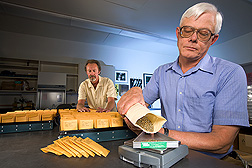Washington, DC
November 27, 2007
 |
|
Plant pathologist
Blair Goates (left) and agronomist Harold
Bockelman prepare seed samples from the National
Small Grains Collection to be sent to east
Africa for testing against new races of the stem
rust pathogen.
Photo by Peggy Greb. |
|
Traditional wheats, grown by
village farmers on the other side of the world, could hold genes
that resist attack by stem rust. Killer races of that formidable
fungal disease pose a threat to America's wheat, according to
Agricultural Research Service (ARS)
plant pathologist
J. Michael Bonman.As
leader of the
ARS Small Grains and Potato Germplasm Research Unit,
Aberdeen, Idaho, Bonman directs a fast-paced, high-intensity
search for wheats that could fend off rusts now emerging in east
Africa. The team's focus is on the world's locally grown wheats,
known to scientists as "landraces." These wheats typically are
not as well-studied as those grown commercially on thousands of
acres in the United States, for instance.
However, thanks to years of
work by generations of plant explorers, breeders and others,
seeds of 25,000 different kinds of local wheats are already at
hand in a special collection at the Aberdeen research center.
The collection, curated by ARS agronomist
Harold E. Bockelman, serves as America’s official genebank
of wheats gathered from around the planet.
To learn more about the rust
resistance of the genebank’s landrace wheats, Bonman and
colleagues combed decades-old records of the disease-fighting
prowess of nearly 8,500 specimens. Plant pathologist Don V.
McVey, now retired from the
ARS Cereal Disease Laboratory, St. Paul, Minn., created
those records when he tested the plants, beginning in 1988.
Though McVey couldn’t have
exposed the plants to the new wheat stem rusts now damaging
wheatfields of east Africa, his test results are nonetheless
still relevant today, according to Bonman.
The new analyses of McVey’s
findings revealed notable resistance in wheats from, among other
places, Chile, Ethiopia, Turkey, and Bosnia and Herzegovina. The
scientists are now intensifying their analyses of other genebank
landraces from these areas—not just those that McVey studied.
And, they're using the findings to choose specimens to send to
Kenya and Ethiopia, for testing in the heart of the rust
epidemic.
Read more about the research in the November/December 2007
issue of Agricultural Research magazine.
ARS is the
U.S. Department of Agriculture's
chief scientific research agency.
By
Marcia
Wood
Las variedades tradicionales de
trigo cultivadas por granjeros todas partes del mundo podrían
tener algunos genes que ayudan a las plantas a resistir ataques
por la roya del tallo. Las razas letales de esa enfermedad
fungal son una amenaza al trigo estadounidense, según el
patólogo de plantas del Servicio de Investigación Agrícola (ARS)
J. Michael Bonman.
En su papel como líder de la
Unidad de Investigación de Granos Pequeños y Germoplasma de Papa
mantenida por ARS en Aberdeen, Idaho, Bonman dirige una búsqueda
intensiva para variedades de trigo que podrían rechazar las
royas del tallo que ahora están apareciendo en África Oriental.
El foco del grupo es las variedades de trigo cultivadas
localmente, conocidos como variedades criollas o "landraces".
Estos trigos típicamente no son bien estudiados como aquellos
comercialmente cultivados en miles de acres en EE.UU., por
ejemplo.
Sin embargo, gracias a los años
de intentos por generaciones de exploradores de plantas,
criadores y otras personas, las semillas de 25.000 diferentes
tipos de trigos locales ya están disponibles en una colección
especial en el centro de investigación en Aberdeen. La
colección, mantenida por el agrónomo del ARS
Harold E. Bockelman, sirve como el banco oficial de genes de
trigo colectado desde todas partes del mundo.
Para aprender más sobre la
capacidad de algunas variedades criollas para resistir la roya
del tallo, Bonman y sus colegas investigaron décadas de archivos
sobre casi 8.500 especímenes. El patólogo de plantas Don V.
McVey, ahora retirado del
Laboratorio de Enfermedades de Cereal mantenido por ARS en
St. Paul, Minnesota, creó estos archivos durante sus pruebas de
las plantas, comenzando en el 1988.
Aunque McVey no podía exponer
las plantas a las nuevas razas de la roya de tallo del trigo que
ahora dañan los campos de trigo de África Oriental, los
resultados de sus pruebas todavía son relevantes, según Bonman.
Un nuevo análisis de los
hallazgos de McVey reveló una resistencia notable en los trigos
de Chile, Etiopia, Turquía, y Bosnia y Herzegovina, así como
otros lugares. Los científicos ahora quieren intensificar su
análisis de otras variedades criollas en el banco de genes que
provienen de estas áreas — no sólo aquellas estudiadas por
McVey. Los investigadores también están usando los hallazgos
para escoger especímenes para enviar a Kenya y Etiopia para
utilización en pruebas en el centro de la epidemia de la roya
del tallo.
Lea más sobre la investigación en la revista 'Agricultural
Research' de noviembre/diciembre 2007.
ARS es la agencia principal
de investigaciones científicas del
Departamento de Agricultura de
EE.UU.
|